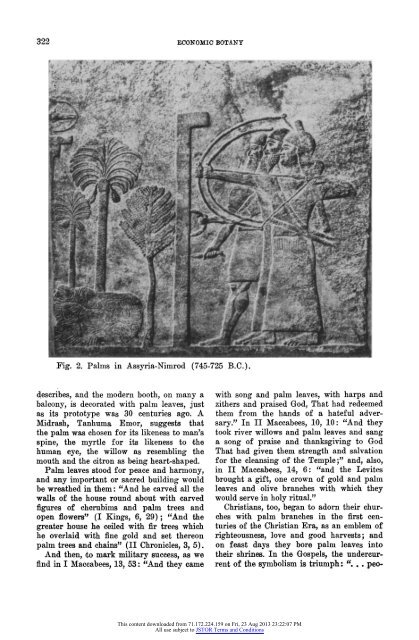The History of the Date through the Ages in the Holy Land
The History of the Date through the Ages in the Holy Land
The History of the Date through the Ages in the Holy Land
You also want an ePaper? Increase the reach of your titles
YUMPU automatically turns print PDFs into web optimized ePapers that Google loves.
322 ECONOMIC BOTANY<br />
Fig. 2. Palms <strong>in</strong> Assyria-Nimrod (745-725 B.C.).<br />
describes, and <strong>the</strong> modern booth, on many a<br />
balcony, is decorated with palm leaves, just<br />
as its prototype was 30 centuries ago. A<br />
Midrash, Tanhuma Emor, suggests that<br />
<strong>the</strong> palm was chosen for its likeness to man's<br />
sp<strong>in</strong>e, <strong>the</strong> myrtle for its likeness to <strong>the</strong><br />
human eye, <strong>the</strong> willow as resembl<strong>in</strong>g <strong>the</strong><br />
mouth and <strong>the</strong> citron as be<strong>in</strong>g heart-shaped.<br />
Palm leaves stood for peace and harmony,<br />
and any important or sacred build<strong>in</strong>g would<br />
be wrea<strong>the</strong>d <strong>in</strong> <strong>the</strong>m: "And he carved all <strong>the</strong><br />
walls <strong>of</strong> <strong>the</strong> house round about with carved<br />
figures <strong>of</strong> cherubims and palm trees and<br />
open flowers" (I K<strong>in</strong>gs, 6, 29); "And <strong>the</strong><br />
greater house he ceiled with fir trees which<br />
he overlaid with f<strong>in</strong>e gold and set <strong>the</strong>reon<br />
palm trees and cha<strong>in</strong>s" (II Chronicles, 3, 5).<br />
And <strong>the</strong>n, to mark military success, as we<br />
f<strong>in</strong>d <strong>in</strong> I Maccabees, 13, 53: "And <strong>the</strong>y came<br />
with song and palm leaves, with harps and<br />
zi<strong>the</strong>rs and praised God, That had redeemed<br />
<strong>the</strong>m from <strong>the</strong> hands <strong>of</strong> a hateful adversary."<br />
In II Maccabees, 10, 10: "And <strong>the</strong>y<br />
took river willows and palm leaves and sang<br />
a song <strong>of</strong> praise and thanksgiv<strong>in</strong>g to God<br />
That had given <strong>the</strong>m strength and salvation<br />
for <strong>the</strong> cleans<strong>in</strong>g <strong>of</strong> <strong>the</strong> Temple;" and, also,<br />
<strong>in</strong> II Maccabees, 14, 6: "and <strong>the</strong> Levites<br />
brought a gift, one crown <strong>of</strong> gold and palm<br />
leaves and olive branches with which <strong>the</strong>y<br />
would serve <strong>in</strong> holy ritual."<br />
Christians, too, began to adorn <strong>the</strong>ir churches<br />
with palm branches <strong>in</strong> <strong>the</strong> first centuries<br />
<strong>of</strong> <strong>the</strong> Christian Era, as an emblem <strong>of</strong><br />
righteousness, love and good harvests; and<br />
on feast days <strong>the</strong>y bore palm leaves <strong>in</strong>to<br />
<strong>the</strong>ir shr<strong>in</strong>es. In <strong>the</strong> Gospels, <strong>the</strong> undercurrent<br />
<strong>of</strong> <strong>the</strong> symbolism is triumph: ". . peo-<br />
This content downloaded from 71.172.224.159 on Fri, 23 Aug 2013 23:22:07 PM<br />
All use subject to JSTOR Terms and Conditions
















